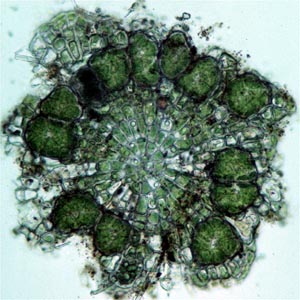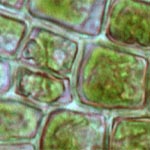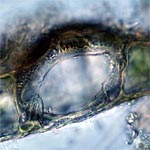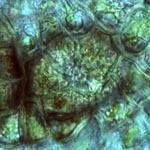Coleochaete orbicularis Pringsheim
Classification: Eukarya, Charophyta, Charophyceae, Coleochaetales, Coleochaetaceae
Synonomy: C. scutata
var. reticulata Jao; Coleochaete pulchella Papenfuss (Kutzing)
Note: the name "C. orbicularis" has a checkered history.
Originally used by Pringsheim (1860?), it is unclear whether Prinsheim
applied it to the organism shown here. To be consistent with modern usage,
the name C. orbicularis will be lectotypified on an illustration
by Pringsheim (1860), and epitypified on material provided by L. Graham
(Cimino et al., in prep). (MORE)
Description: Up to 1mm in diameter. Discoidal and pseudoparenchymatous; vegetative tissue is a single layer of cells. Cells box-like, X x X µm (l:w). Hair cells with hairs dorsal and medial, hari sheath X x X µm. Chloroplasts dorsal and parietal except in hair cells, typically with a single conspicuous pyrenoid. Zoospores are produced from seemingly undifferentiated cells, and are released via a circular pore on the dorsal surface of the zoosporangium. Monoecious, with 2-4 chambered antheridia forming proximally to the oogonia. Zygotes, when present, are corticated and have placental transfer cell wall ingrowths, X - X µm in diameter with a single chloroplast. Zygote germination occurs in early spring in temperate areas, is preceded by chloroplast division and meiosis, and results in the formation of 8-16 (32) meiospores/zygote in distinctive meiospore chambers. Initial germling with a single hair cell above, and a vegetative cell below that gives rise to the rest of the thallus.
Distinguished from C. scutata by its monoecious habit (but see Cimino et al., unpublished) and transfer cell wall ingrowths, from C. soluta by T-shaped cell division, and from the C. circularis group by T-shaped cell division and corticated zygotes.

C. orbicularis from Lake
Tomohawk, Oneida Co., WI.
Thallus ca. 200 micrometers diameter. [CFD m9.6, 14 Nov. 1988]
Additional Information
Among the best-studied members of the Coleochaetales, the structural complexity has often inspired comparisons to the embryophyes (land plants). Molecular phylogenetic analyses indicate that the Coleochaetales and Charales are closely related to embryophytes, but Coleochaete orbicularis is no more closely related to embryophytes than are other Coleochaetales.
How to find it: Occurs worldwide, in both temperate and tropical areas. Found on the stems of aquatic plants and other solid surfaces in still or slow-moving fresh water. Requires oligotrophic to mesotrophic conditions. Available from UTEX, #LB2651.
How to grow it: Unialgal cultures can be established by micropipette isolation of zoospores and meiospores. Grows well in Guillard's Freshwater Medium.
Key Literature: Pringsheim, 1860. Jahrb. Wiss. Bot. 2:1-36. Szymanska and Spalik, 1993.Archiv f. Hydrobio. 98:XXX-XXX. Cimino et al., in prep. Taxon XX:XXX-XXX. Graham 1993. Origin of Land Plants, John Wiley and Sons. (MORE)


